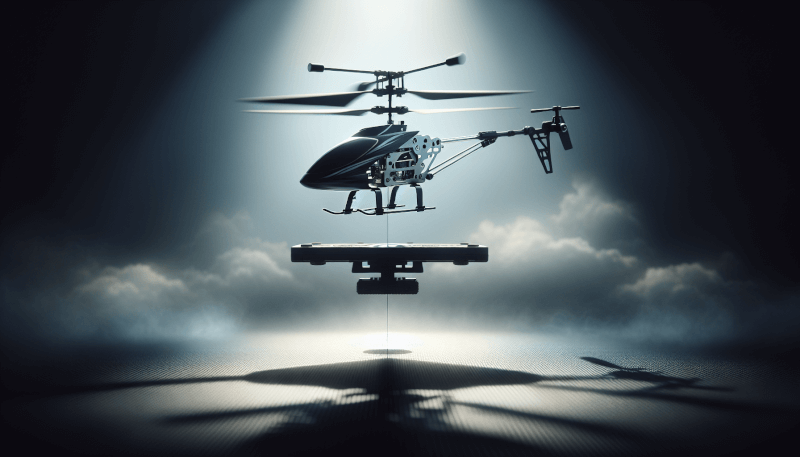Properly balancing your RC heli is vital for achieving smooth, controlled flight and preventing unnecessary crashes. When your heli is properly balanced, it becomes more stable, responsive, and easier to control. This article will guide you through the importance of balancing your RC heli, the potential consequences of neglecting this crucial step, and the simple methods to ensure that your heli is perfectly balanced for optimal performance. So, let’s dive into the world of RC helicopters and discover the significance of proper balance!

1. Understanding the Concept of Balance
1.1 Why is balance important in RC helicopters?
When it comes to RC helicopters, balance plays a crucial role in their overall performance and flight characteristics. Achieving proper balance is essential for ensuring stability, control, and optimal flight performance. In the absence of balance, an RC heli can exhibit unpredictable behaviors such as drifting, wobbling, or even becoming uncontrollable in flight. Therefore, understanding the importance of balance and how it affects your RC heli is key to enjoying a smooth and successful flight experience.
1.2 What is meant by balance in RC helis?
In the context of RC helicopters, balance refers to the equal distribution of weight throughout the aircraft. This means that all components, including the main and tail rotor blades, batteries, electronics, and other parts, should be properly aligned and positioned to maintain equilibrium. When a heli is well-balanced, it prevents any excessive tilting, favoring of one side, or unnecessary vibrations during flight.
1.3 How does balance affect the performance of an RC heli?
The balance of an RC heli directly impacts its performance in several ways. Firstly, a well-balanced heli enhances stability and control during flight maneuvers. It allows for precise control inputs without the risk of sudden jerks or unexpected movements. Additionally, a balanced heli improves flight performance by reducing drag and increasing efficiency, resulting in smoother and longer flights. Lastly, proper balance minimizes vibrations, thereby reducing wear and tear on the crucial components of the helicopter, such as the motor and gears.
2. Methods of Balancing an RC Heli
2.1 Static balancing
Static balancing is the initial step to achieve overall balance in an RC helicopter. This method involves verifying the balance of the main rotor blades and tail rotor blades when the heli is at rest. One common approach is to use a balancing stand or jig to suspend the heli and allow it to naturally settle into a balanced position. This will help identify any imbalances in the blades, which can be corrected using tape or adhesive weights.
2.2 Dynamic balancing
Dynamic balancing takes into account the movements and forces experienced during flight. This technique involves spinning the main rotor blades or tail rotor blades at a controlled speed while monitoring vibrations and oscillations. By carefully adjusting the positions of the blades or adding small weights, dynamic balancing ensures that the heli remains stable and vibrations are minimized during actual flight conditions.
2.3 Use of gyroscopes for balance
Gyroscopes are electronic devices commonly used in RC helicopters to assist with balance and stability. These sensors detect any deviation from the desired position and automatically make adjustments to keep the heli stable. By continuously monitoring and correcting for imbalances, gyros play a vital role in maintaining the overall balance of the heli, especially in challenging flying conditions or during advanced maneuvers.
3. Benefits of Properly Balancing Your RC Heli
3.1 Enhanced stability and control
Properly balancing your RC heli enhances its stability and control, allowing for smoother flying experiences. With the weight distribution evenly distributed, the heli will respond more predictably to your control inputs, making it easier to perform maneuvers with precision and confidence. Whether you’re a beginner or an experienced pilot, having a well-balanced heli will greatly contribute to your overall flying enjoyment.
3.2 Improved flight performance
A balanced RC heli can experience improved flight performance in terms of efficiency and speed. By reducing drag caused by imbalanced components, the heli can glide through the air more effortlessly, resulting in longer flight times. Additionally, a balanced heli is less prone to unnecessary resistance, allowing for quicker acceleration and smoother deceleration during flight.
3.3 Reduced vibrations and wear on components
Balancing your RC heli helps minimize vibrations, which can have significant consequences on the longevity of your aircraft. Vibrations can cause excessive stress on various components, such as the motor, gears, and even electronic systems. By properly balancing your heli, you can reduce the vibrations and subsequently decrease the wear and tear on these delicate parts, ultimately increasing the overall lifespan of your RC helicopter.
4. Tools and Equipment for Balancing
4.1 Balancing stand or jig
A balancing stand or jig is an essential tool for static balancing your RC heli. It provides a stable platform to suspend the heli in a level position, allowing the blades to settle naturally and revealing any imbalances. Invest in a high-quality balancing stand or jig to ensure accurate and reliable results during the balancing process.
4.2 Bubble level
A bubble level is a simple yet effective tool for achieving accurate balance. Placing the bubble level on various parts of the heli, such as the blades or the main rotor head, will help determine if they are properly aligned and parallel to the ground. This ensures that the weight is distributed evenly and that the heli is in an optimal position for smooth flight.
4.3 Digital scale
A digital scale is an invaluable tool for measuring and verifying the weight distribution of the various components on your RC heli. By accurately weighing each part, you can identify any significant deviations from the optimal balance and take appropriate corrective actions.
4.4 Tape or adhesive weights
To correct imbalances in the blades or other components, tape or adhesive weights can be applied. These small weights can be strategically placed on the blades or other parts to achieve the desired balance. It is important to ensure that the weights are securely attached to prevent them from coming loose during flight.

5. Step-by-Step Guide to Balancing Your RC Heli
5.1 Inspecting and identifying imbalances
Begin by carefully inspecting your RC heli for any visible signs of imbalance. Look for parts that appear misaligned, uneven, or damaged. By visually inspecting the heli, you can identify potential areas that require attention during the balancing process.
5.2 Balancing main rotor blades
Start by placing your heli on a balancing stand or jig, ensuring it is level. Rotate the blades and observe if they settle in a balanced position or if one side is consistently heavier. Use tape or adhesive weights to adjust the balance by adding them to the lighter side of the blades. Repeat this process until the blades are evenly balanced.
5.3 Balancing tail rotor blades
Similar to the main rotor blades, the tail rotor blades should also be balanced for optimal heli performance. Follow the same procedure as balancing the main rotor blades by using a balancing stand or jig. Adjust any imbalances by applying tape or adhesive weights as needed.
5.4 Checking balance after modifications or repairs
Whenever you make modifications or repairs to your RC heli, it is crucial to check the balance again. Changes in weight or the addition of new components can lead to imbalances and affect flight performance. Repeat the balancing process outlined earlier to ensure that your heli remains properly balanced after any modifications or repairs.
6. Common Mistakes to Avoid During Balancing
6.1 Neglecting small imbalances
Even minor imbalances can have a significant impact on the performance of your RC heli. It is essential to address both large and small imbalances during the balancing process to achieve optimal results. Take the time to fine-tune the balance, as this will greatly contribute to a smoother and more enjoyable flight experience.
6.2 Failing to recheck balance after adjustments
After making any adjustments during the balancing process, it is crucial to recheck the balance to ensure that the changes have been effective. Failing to do so may result in an inaccurate balance, leading to potential issues during flight. Take the extra step to reevaluate the balance and make any additional adjustments if necessary.
6.3 Overlooking the importance of balancing tail rotor
While much of the focus is often on balancing the main rotor blades, it is equally important not to overlook the balancing of the tail rotor blades. Neglecting the balance of the tail rotor can result in unwanted yaw or tail wag during flight. Remember to allocate time to properly balance both sets of blades for optimal performance.
6.4 Using incorrect balance point or incorrect weights
Using the wrong balance point or incorrect weights can lead to imprecise balance and potential flight issues. It is crucial to consult the manufacturer’s guidelines or seek advice from experienced RC heli enthusiasts to determine the correct balance point and weight distribution for your specific model. Using the right tools, equipment, and weights will help you achieve accurate and reliable balance.

7. Factors Affecting the Balance of an RC Heli
7.1 Distribution of weight
The distribution of weight is a key factor affecting the balance of an RC heli. Properly distributing the weight ensures that the heli remains stable during flight and minimizes unnecessary strains on various components. It is important to consider the placement of batteries, electronics, and other accessories to achieve an optimal weight distribution.
7.2 Alignment of components
The alignment of components plays a significant role in achieving balance. Misaligned parts can introduce imbalances, leading to unpredictable flight behavior. Take the time to carefully align the main rotor blades, tail rotor blades, and other components to ensure they are parallel and properly positioned.
7.3 Blade tracking and pitch
Blade tracking and pitch directly impact the balance of an RC heli. Proper tracking ensures that the main rotor blades are in sync, reducing vibrations and enhancing flight performance. Likewise, accurate pitch settings contribute to balanced flight characteristics, ensuring that both lift and stability are optimized.
7.4 Center of gravity
The center of gravity (CG) is a critical factor in achieving balance. The CG is the point where the weight of the heli is evenly distributed. It is important to locate and maintain the CG within the recommended range specified by the manufacturer. Deviations from the optimal CG can result in unstable flight behavior.
8. Importance of Balance During Flight
8.1 Impact on stability and maneuverability
Balance plays a fundamental role in the stability and maneuverability of an RC heli during flight. A well-balanced heli is more resistant to external factors such as wind and turbulence, allowing for smoother and more controlled maneuvers. With proper balance, you can execute precise turns, flips, and other aerial stunts with confidence.
8.2 Influence on battery life and flight time
Balanced flight dynamics significantly affect battery life and flight time. A properly balanced heli requires less energy for stabilization and control, resulting in more efficient power usage and extended flight times. By reducing unnecessary power consumption due to imbalances, you can maximize the enjoyment of your flights without frequent battery changes.
8.3 Reduction of stress on the drive system
The balance of an RC heli plays a crucial role in reducing the stress on the drive system, including the motor, gears, and servos. Imbalances can introduce excessive vibrations and strains on these vital components, leading to premature wear and potential failures. By maintaining proper balance, you minimize the risk of mechanical issues and extend the lifespan of your RC heli.
8.4 Prevention of excessive vibrations
One of the main benefits of balancing your RC heli is the reduction of excessive vibrations. Vibrations not only affect flight stability but also contribute to premature wear of components and potentially damage the delicate electronic systems onboard. Properly balancing your heli ensures a smoother, more enjoyable flight experience, while reducing the harmful effects of vibrations on the aircraft.

9. Resources and Techniques for Advanced Balancing
9.1 Computerized balancing systems
For advanced balancing needs, computerized balancing systems are available. These systems utilize advanced algorithms and sensors to precisely measure and correct imbalances in real-time. They provide detailed reports and recommendations for achieving optimal balance, taking your RC heli’s performance to the next level.
9.2 Use of vibration analyzers
Vibration analyzers are valuable tools for advanced balancing, particularly to identify and quantify vibrations in different areas of the heli. By pinpointing the sources and magnitudes of vibrations, you can take targeted corrective actions, resulting in a more refined and balanced flying experience.
9.3 Fine-tuning with digital pitch gauges
Digital pitch gauges offer precise measurements for monitoring and adjusting the pitch of your heli’s blades. By fine-tuning the pitch settings, you can achieve better balance and optimize lift and control during flight. Digital pitch gauges provide accurate readings, allowing for meticulous adjustments to fine-tune your heli’s balance.
9.4 Weight distribution optimization
To further optimize the weight distribution on your RC heli, consider techniques such as relocating batteries or repositioning components. Experiment with different arrangements to achieve the best balance. Work closely with experienced RC enthusiasts or consult online forums to gather valuable insights and tips on weight distribution optimization.
10. Conclusion
10.1 Recap of the importance of proper balancing
Properly balancing your RC heli is paramount for achieving optimal stability, control, and flight performance. By ensuring an even distribution of weight, alignment of components, and adjusting the balance of rotor blades, you can enjoy a smoother and more enjoyable flying experience.
10.2 Tips for maintaining balance
To maintain the balance of your RC heli, make it a habit to regularly inspect and check for imbalances before each flight. Address any noticeable imbalances promptly and recheck the balance after modifications or repairs. Additionally, keep an eye on the distribution of weight and ensure components remain aligned throughout the lifespan of your heli.
10.3 Final thoughts and encouragement
Balancing your RC heli may initially seem daunting, but with the right knowledge, tools, and techniques, it becomes a rewarding and beneficial process. Remember to take your time, follow step-by-step procedures, and seek guidance when needed. Properly balanced heli will enhance your flying experience, allowing you to perform advanced maneuvers with confidence and joy. Embrace the challenge of balancing and unlock the full potential of your RC heli!



